The 30 Best Restaurants in the U.S. According to Top Food Critics

The United States boasts an extraordinary culinary landscape that spans from innovative fine dining establishments in major metropolitan areas to groundbreaking farm-to-table concepts in smaller communities.
This comprehensive guide identifies the 30 most exceptional restaurants across America, featuring renowned establishments that have earned critical acclaim for their culinary excellence, innovative approaches, and memorable dining experiences.
The selection encompasses diverse cuisines, cooking styles, and price points that represent the pinnacle of American gastronomy.
From Michelin-starred venues in New York City and San Francisco to pioneering restaurants that have redefined regional American cuisine, these establishments demonstrate the creativity and skill that define contemporary dining in the United States.
The restaurants featured range from intimate chef-driven experiences to iconic institutions that have shaped American food culture.
Each venue offers distinct qualities that set them apart in terms of ingredient sourcing, culinary technique, service standards, and overall dining atmosphere.
Here are the 30 best restaurants in the U.S.
1. Eleven Madison Park, New York City
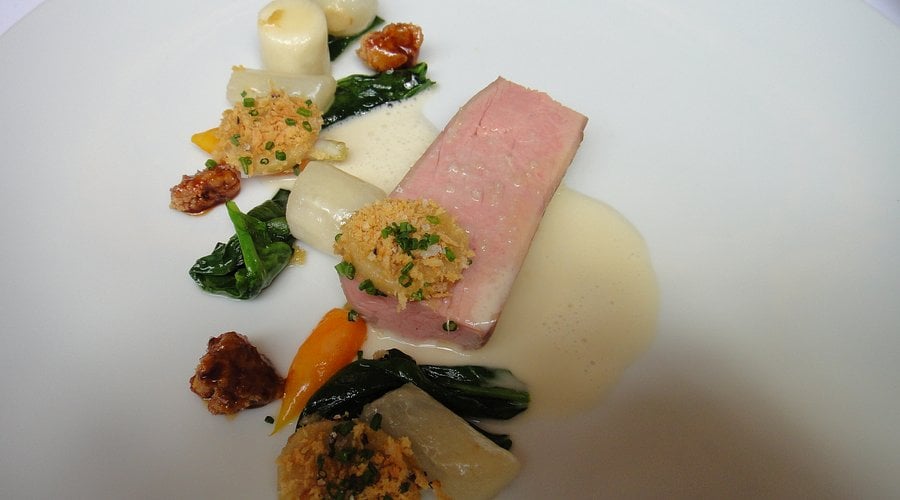
Eleven Madison Park stands as New York City’s crown jewel of fine dining. Chef Daniel Humm leads this three-Michelin-starred restaurant located at 11 Madison Avenue.
The restaurant earned the top spot on The World’s 50 Best Restaurants list in 2017. It has maintained its position among the world’s elite dining destinations since opening in 1998.
In 2021, Eleven Madison Park made a bold transition to an entirely plant-based menu. This shift demonstrates the restaurant’s commitment to culinary innovation while maintaining its exceptional standards.
The dining room overlooks Madison Square Park from within a historic Art Deco building. The elegant interior complements the restaurant’s reputation for impeccable service and seasonally-driven cuisine.
Eleven Madison Park holds four stars from The New York Times alongside its three Michelin stars. These accolades reflect the restaurant’s consistent excellence in both cuisine and hospitality.
2. Alinea, Chicago
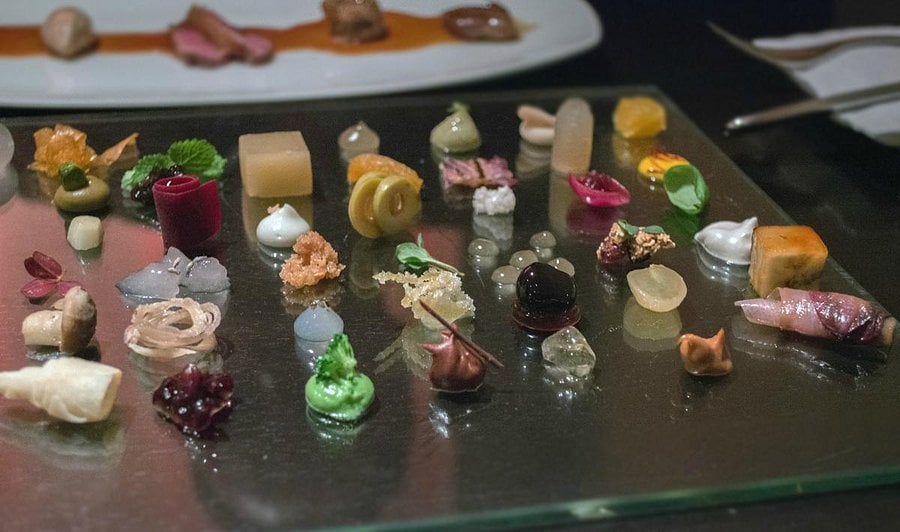
Alinea stands as one of America’s most influential restaurants, earning three Michelin stars consistently since 2011. Chef Grant Achatz leads this Lincoln Park establishment with groundbreaking molecular gastronomy techniques.
The restaurant transforms dining into theatrical performance. Meals feature scented vapors, interactive tableside presentations, and custom resin dishes that challenge traditional expectations.
Executive Chef Douglas Alley works alongside Achatz to create whimsical, experimental dishes. Each course surprises diners through innovative cooking methods and artistic presentation.
Alinea holds numerous prestigious awards including James Beard honors for Outstanding Restaurant and Outstanding Chef. The World’s 50 Best Restaurants named it Best Restaurant in North America.
Tasting menus start at $325, with premium experiences reaching higher price points. The restaurant offers three distinct dining experiences nightly at 1723 North Halsted Street, solidifying Chicago’s reputation as a world-class culinary destination.
3. The French Laundry, Yountville
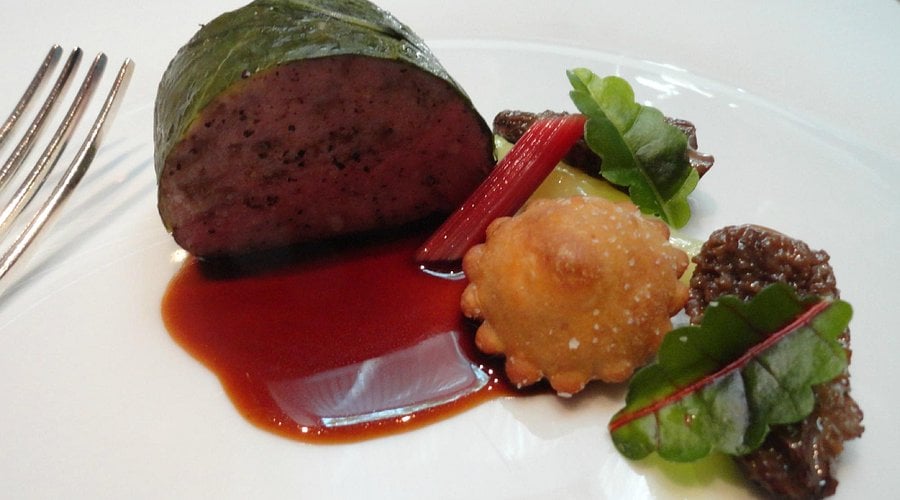
Chef Thomas Keller’s flagship restaurant opened in 1994 in a historic stone cottage originally built as a saloon in 1900. The French Laundry holds three Michelin stars and earned recognition as the world’s best restaurant in 2003 and 2004.
Located in Napa Valley’s Yountville, the 1,600 square-foot restaurant showcases French technique with American cuisine. Keller remains the only American chef to maintain three Michelin stars at two restaurants simultaneously.
The restaurant offers a nine-course tasting menu featuring seasonal ingredients and precise execution. Reservations are notoriously difficult to secure due to its legendary status.
The stone building’s intimate dining rooms create an elegant atmosphere. The restaurant consistently appears on top restaurant lists and attracts diners from around the world seeking exceptional fine dining.
4. Le Bernardin, New York City
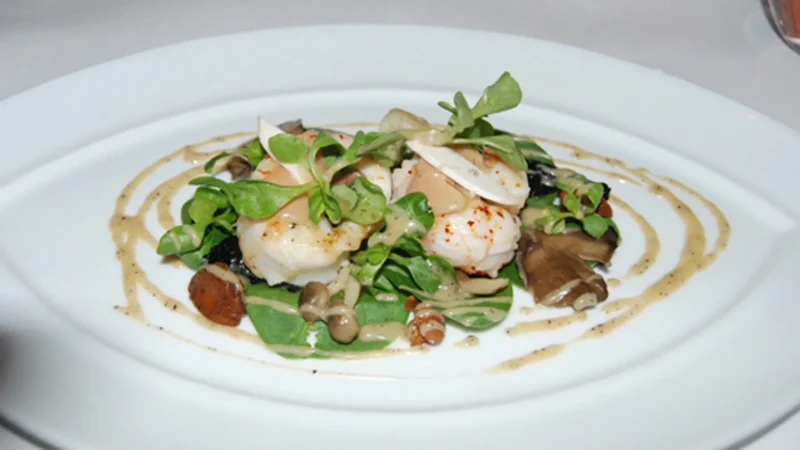
Le Bernardin stands as New York’s premier seafood destination in Midtown Manhattan. Executive chef Eric Ripert and co-owner Maguy Le Coze have maintained this French restaurant’s exceptional standards for nearly three decades.
The restaurant holds three Michelin stars and earned The New York Times’ coveted four-star rating. Le Bernardin consistently ranks among the world’s top restaurants, claiming the number one spot on La Liste’s global rankings.
Originally founded in Paris in 1972, the restaurant relocated to New York in 1986. Since then, it has become synonymous with world-class seafood preparation and impeccable service.
Chef Ripert’s culinary expertise transforms fresh fish and crustaceans into refined dishes. The kitchen executes preparations like seared langoustine in truffled broth and golden-brown fluke with bouillabaisse sauce.
Le Bernardin continues to attract discerning diners and industry leaders, cementing its reputation as an essential fine dining experience.
5. Per Se, New York City

Per Se stands as Thomas Keller’s acclaimed fine dining destination in the Deutsche Bank Center at Columbus Circle. The restaurant opened in 2004 as Keller’s New York interpretation of his renowned French Laundry.
The establishment holds three Michelin stars, placing it among only seven New York restaurants with this distinction. Every table offers views of Central Park and Columbus Circle through carefully designed seating arrangements.
Per Se serves a nine-course tasting menu priced at $425, with both omnivore and vegetarian options available daily. The menus change regularly, featuring refined techniques and seasonal ingredients.
The restaurant operates as a service-included establishment, eliminating traditional tipping. Reservations require significant advance planning due to high demand and limited seating in the intimate dining room designed by Adam D. Tihany.
6. Momofuku Ko, New York City

Momofuku Ko earned two Michelin stars during its 15-year run in New York City’s East Village. Chef David Chang’s intimate restaurant operated at 8 Extra Place, offering a meticulously crafted tasting menu.
The restaurant featured a chef’s counter experience with upwards of 17 courses. Chef Sean Gray led the kitchen, creating innovative dishes that blended precision and bold flavors.
Ko transformed the American fine dining landscape through its postmodern omakase approach. The restaurant set standards for contemporary tasting menus in New York City.
The establishment closed in November 2024 after operating since 2004. The space now houses Bar Kabawa, a new Momofuku concept focusing on Caribbean cuisine that opened in early 2025.
7. Blue Hill at Stone Barns, Pocantico Hills
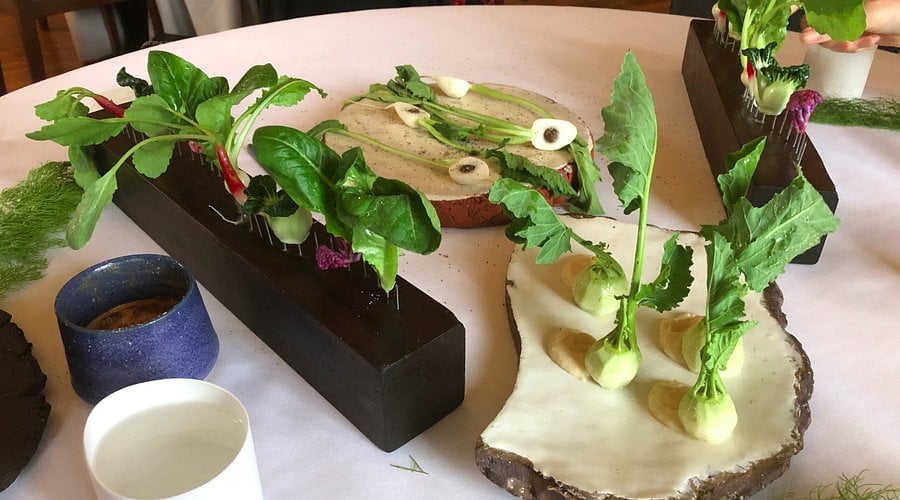
Blue Hill at Stone Barns operates without traditional menus. Instead, the restaurant crafts multi-course tasting experiences based on daily farm harvests and seasonal availability.
The two Michelin-starred establishment sources ingredients from surrounding fields and local Hudson Valley farms. Each meal begins with a tour of the working farm before dinner service.
Executive chef Dan Barber leads the culinary team alongside his co-owners. The restaurant opened in 2004 and has earned recognition on the World’s 50 Best Restaurants list.
Guests can expect unconventional presentations and creative preparations. The dining experience emphasizes sustainability and showcases whole grains, preservation techniques, and expert butchery.
Reservations require advance planning through email contact. The restaurant operates Wednesday through Saturday for dinner service, with Sunday lunch also available.
The Stone Barns Center location in Westchester County provides the agricultural foundation for the restaurant’s farm-to-table philosophy.
8. Quince, San Francisco
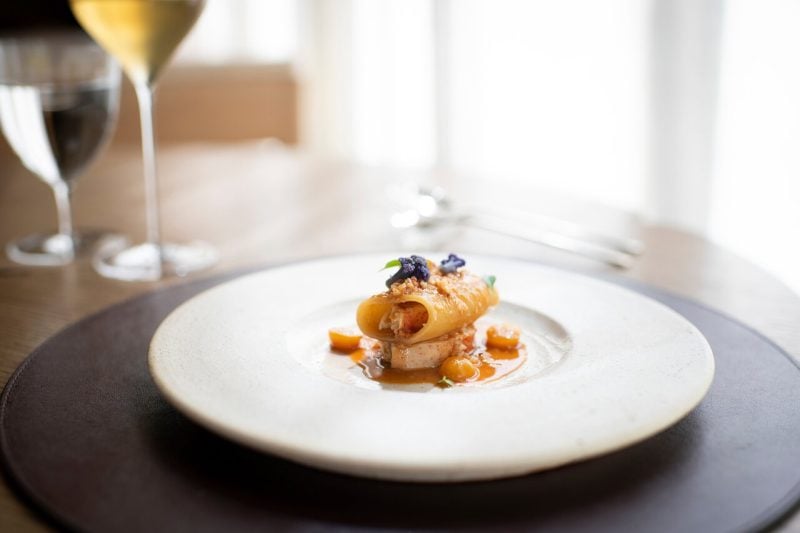
Quince stands as one of San Francisco’s most distinguished dining establishments, earning three Michelin stars since opening in 2003. The restaurant occupies a prime location in the historic Jackson Square district.
The kitchen delivers a hyper-seasonal tasting menu that blends French and Italian culinary traditions. Fresh pasta and sophisticated preparations showcase the chef’s technical expertise.
Guests can expect a ten-course experience priced at $390 per person. The investment reflects the restaurant’s commitment to premium ingredients and exceptional service standards.
The New York Times recently recognized Quince among America’s top 50 restaurants. This acknowledgment reinforces its position within the nation’s elite dining scene.
The wine program features extensive selections from both France and Italy. Barolo and champagne complement the menu’s European-inspired direction perfectly.
9. Zahav, Philadelphia
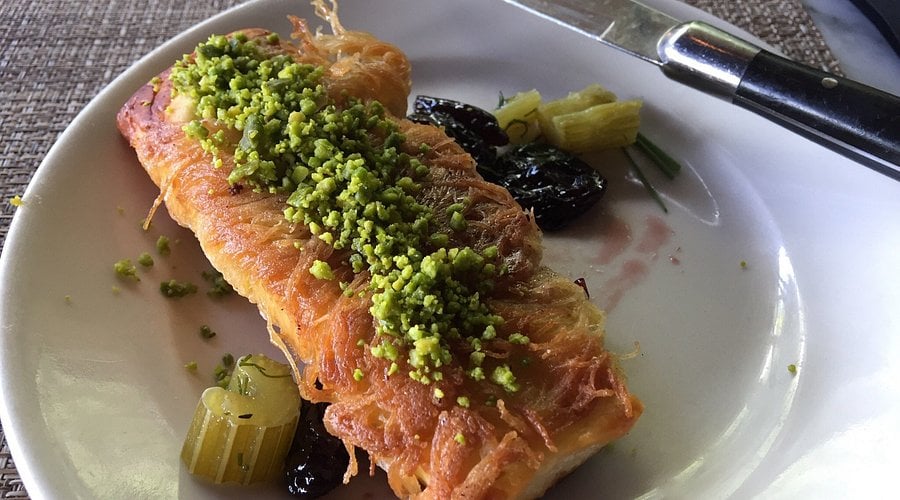
Zahav earned the James Beard Award for Outstanding Restaurant in 2019, marking it as the best restaurant in America. The Israeli eatery in Society Hill has been serving innovative Middle Eastern cuisine since 2008.
Chef Michael Solomonov and partner Steve Cook created a restaurant that showcases traditional Israeli flavors through contemporary small plates. The menu reflects Israel’s cultural crossroads and evolving culinary landscape.
The restaurant’s silky hummus served on laffa bread has become legendary among diners. Zahav offers a warm, inviting atmosphere suitable for casual dates or celebratory meals.
Beyond the James Beard recognition, Zahav has received acclaim from Esquire and Philadelphia Magazine. The restaurant consistently draws praise for its groundbreaking approach to Israeli cuisine and exceptional hospitality.
10. Osteria Mozza, Los Angeles
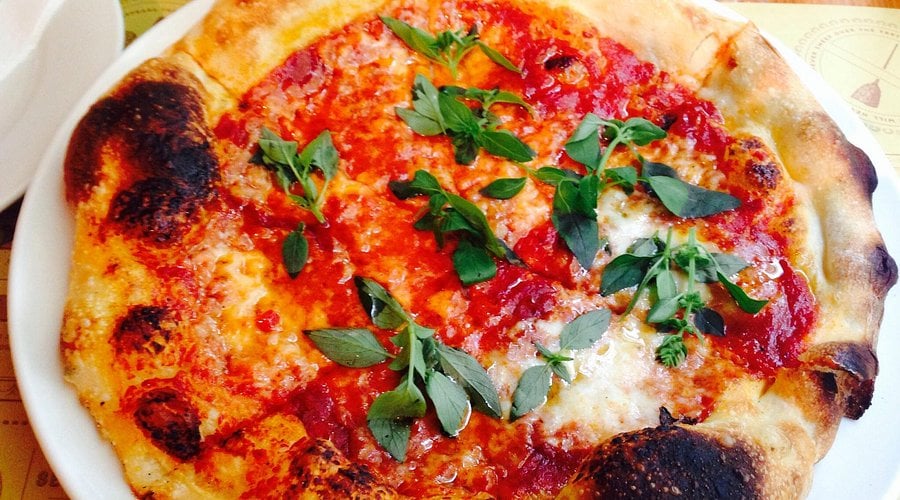
Chef Nancy Silverton’s Osteria Mozza on Melrose Avenue has earned its reputation as one of LA’s premier Italian restaurants. The establishment holds a Michelin star for its exceptional cuisine and creative approach to traditional Italian dishes.
The restaurant’s famous mozzarella bar features imported Carrara marble where fresh mozzarella, ricotta, and burrata are prepared daily. Diners can watch the antipasti preparation from prime bar seats.
The signature raviolo delivers a perfect combination of ricotta cheese and bright egg yolk. Fresh bread receives special attention, reflecting the chef’s dedication to quality ingredients.
Dark wood paneling and white marble counters create an upscale atmosphere that departs from typical osteria styling. The restaurant maintains consistent popularity since opening, though guests should expect potential wait times even with reservations.
Creative cocktails complement the Italian menu, making Osteria Mozza a complete dining experience that showcases Californian-Italian fusion at its finest.
11. Benu, San Francisco
Benu opened in 2010 under chef Corey Lee, who previously worked at French Laundry. The restaurant operates in San Francisco’s SoMa district at 22 Hawthorne Street.
Chef Lee combines Korean and Chinese culinary traditions with California ingredients. This approach creates contemporary cuisine that has earned significant recognition.
Benu became the first San Francisco restaurant to receive three Michelin stars in 2014. The restaurant has maintained this rating for ten consecutive years through 2024.
The establishment made its debut on The World’s 50 Best Restaurants list in 2019. It ranked 28th on the list in 2021.
Benu serves a fixed tasting menu each evening featuring seafood and other seasonal ingredients. The restaurant offers wine pairings alongside its dining experience.
The establishment has also earned an AAA Five Diamond rating for its culinary excellence.
12. Addison, San Diego
Addison stands as San Diego’s first three-Michelin-starred restaurant and Southern California’s only establishment to earn both Five Diamond and Five-Star ratings. The restaurant occupies an elegant space at the Fairmont Grand Del Mar hotel in Carmel Valley.
Chef William Bradley has led the kitchen since 2006, developing a cuisine that blends global influences with California ingredients. His approach emphasizes regional produce and Southern California’s culinary identity.
The dining room features high ceilings and arched windows that frame hillside views. Addison’s menu showcases contemporary Californian haute cuisine through carefully crafted dishes.
The restaurant’s signature sesame-seasoned Koshihikari rice with applewood-smoked sabayon exemplifies Bradley’s style. Each dish reflects the chef’s commitment to transforming local ingredients into refined presentations.
Addison represents the pinnacle of fine dining in San Diego, earning recognition as one of only thirteen three-Michelin-starred restaurants in the United States.
13. SingleThread, Healdsburg
SingleThread Farm Restaurant & Inn stands as one of California’s most acclaimed dining destinations. The restaurant earned three Michelin stars in record time and secured a spot on The World’s 50 Best Restaurants list at number 46 in 2024.
The establishment operates as a unique farm-to-table concept combining agriculture, hospitality, and fine dining. Located in Healdsburg’s wine country, SingleThread sources ingredients from its own farm to create seasonal menus.
Guests experience an eleven-course tasting menu customized to dietary preferences and restrictions. Reservations require advance purchase through Tock’s ticketing system.
La Liste awarded SingleThread a near-perfect score of 99.5 out of 100, placing it among the world’s top restaurants. The restaurant has weathered challenges including forest fires while maintaining its reputation for exceptional cuisine and service in Sonoma County.
14. Manresa, Los Gatos
Manresa stands as one of California’s most celebrated fine dining destinations. Chef David Kinch leads this acclaimed restaurant nestled in the Santa Cruz mountains.
The restaurant showcases farm-to-fork cuisine with international influences. Kinch works with a trusted network of California farmers, ranchers, foragers and fishermen to source ingredients.
Manresa has earned recognition on multiple prestigious lists. The restaurant appeared on the world’s best 50 restaurants ranking and Gayot’s Top 40 Restaurants in the U.S.
Currently, Manresa operates as Ritual at Manresa, featuring rotating pop-up experiences. Each month brings globally acclaimed chefs to take over the kitchen. Kinch curates this lineup as culinary ambassador for the venue.
15. Pineapple & Pearls, Washington D.C.
Chef Aaron Silverman opened Pineapple & Pearls in 2016 as a fine-dining companion to his popular Rose’s Luxury next door. The restaurant name combines symbols of hospitality and elegance.
Located at 715 8th Street SE on Capitol Hill, the intimate venue seats approximately 30 guests. The space offers both a main dining room and chef’s counter seating.
The restaurant serves a nine-course tasting menu priced at $350. Each meal includes paired beverages with or without alcohol. A shorter five-course option is also available.
Pineapple & Pearls operates as a no-tipping establishment with a 22% service charge. This fee covers staff wages and benefits rather than traditional gratuities.
The restaurant has evolved from its original four-hour tasting format. It now offers a more relaxed approach while maintaining its sophisticated culinary standards and Michelin recognition.
16. The Inn at Little Washington, Washington D.C.
The Inn at Little Washington holds the distinction as the first and only three-star Michelin restaurant in the Washington D.C. metropolitan area. This achievement came in 2019, cementing its status among America’s culinary elite.
Chef Patrick O’Connell has guided this establishment for decades in the historic village of Washington, Virginia. The restaurant operates 67 miles west of the nation’s capital in a setting that recalls an earlier era.
The dining room features elaborate decorations with patterned carpets, rich wallpaper, and detailed fabric work. A new glass-enclosed dining room adds modern elegance to the traditional atmosphere.
The menu divides between classic preparations and vegetable-focused dishes. The restaurant offers both traditional and vegetarian tasting menu options for diners seeking multi-course experiences.
The Inn maintains Forbes Five Star and AAA Five Diamond ratings alongside its Michelin recognition.
17. Joe’s Stone Crab, Miami Beach
Joe’s Stone Crab has anchored Miami Beach’s dining scene since 1913. Joe Weiss originally opened this establishment as a small lunch counter before it evolved into a culinary institution.
The restaurant ranks as the 19th most legendary restaurant on Earth according to TasteAtlas. It holds a 4.3 rating on TripAdvisor and sits among Miami Beach’s top dining destinations.
Stone crabs remain the signature draw during their October 15 to May 1 season. The restaurant also serves exceptional fried chicken at reasonable prices alongside classic American cuisine.
Located at 11 Washington Avenue, Joe’s operates with lunch service Friday through Sunday from 11:30 AM to 2:30 PM. The establishment has appeared on numerous television shows including Best Thing I Ever Ate and Man vs Food.
Beyond stone crabs, the menu features creamed spinach with nutmeg and homemade vinegary coleslaw that complement the seafood offerings.
18. The Bazaar by José Andrés, Los Angeles
The Bazaar by José Andrés transforms dining into theatrical entertainment at the SLS Hotel in Beverly Hills. Chef José Andrés creates a carnival atmosphere with sophisticated Spanish cuisine and modern culinary techniques.
The restaurant spans multiple spaces including Rojo and Blanco tapas bars, Saam, and a patisserie. Each area offers distinct experiences within the same venue.
The menu showcases innovative interpretations of classic Spanish dishes. Molecular gastronomy techniques create playful presentations that surprise diners while maintaining authentic flavors.
The Daily Meal recognized Bazaar Meat as one of America’s 101 Best Restaurants. Their bone-in rib-eye from mature California Holstein cows stands as a signature dish.
The restaurant’s location at 465 S. La Cienega Boulevard provides an elegant setting that matches the culinary artistry. Service combines professionalism with the venue’s theatrical spirit.
José Andrés has earned acclaim for creating this destination that balances whimsy with culinary excellence.
19. State Bird Provisions, San Francisco
State Bird Provisions holds a Michelin star and James Beard Award recognition in San Francisco’s Fillmore District. The restaurant revolutionized fine dining by serving New American small plates from dim sum-style trolleys.
Chefs Stuart Brioza and Nicole Krasinski created an inventive approach to contemporary American cuisine. The restaurant originally began with a focus on quail dishes before expanding its creative menu.
Located at 1529 Fillmore Street, State Bird Provisions operates Tuesday through Saturday from 5:30 pm to 10:00 pm. The dining room features an airy, well-lit atmosphere where servers wheel trolleys of dishes between tables.
The restaurant’s unique service style combines high-quality Michelin-starred cooking with an accessible, interactive dining experience. State Bird Provisions has expanded into a restaurant group that includes The Progress and Anchovy Bar.
20. Bavel, Los Angeles
Bavel occupies an airy warehouse space in Los Angeles’ Arts District. The restaurant showcases Middle Eastern cuisine with influences from Israel, Morocco, and Turkey.
Chefs Ori Menashe and Genevieve Gergis opened Bavel after their success with Italian restaurant Bestia. They draw from their family heritage to create authentic Middle Eastern dishes.
The restaurant operates daily from 5pm to 11pm at 500 Mateo Street. Bavel has earned recognition in the Michelin Guide and ranks among top dining destinations.
The wine program focuses on Mediterranean producers alongside California selections. The list changes daily to complement the kitchen’s offerings.
Bavel represents the evolution of Los Angeles dining. The restaurant combines traditional Middle Eastern techniques with local ingredients and modern presentation.
21. Bad Roman, New York City
Bad Roman brings modern Italian dining to Columbus Circle with a contemporary twist on traditional cuisine. The restaurant occupies the third floor of The Shops at Columbus Circle at 10 Columbus Circle.
Quality Branded operates this establishment, the same group behind Don Angie and Quality Italian. The interior combines exposed brick walls with contemporary art installations and thoughtful lighting.
The spacious dining room accommodates large groups without crowding tables together. This makes it particularly suitable for family dining experiences.
Bad Roman serves dinner nightly from 5-11pm and offers weekday lunch Monday through Friday from 11:30am-3pm. Weekend brunch runs Saturday and Sunday from 11am-3pm.
The restaurant balances modern chic design with rustic warmth elements. Soft lighting and carefully arranged seating create an intimate atmosphere despite the large space.
22. Chez Panisse, Berkeley
Chez Panisse opened in 1971 and has shaped American dining for over five decades. The Berkeley restaurant sits at 1517 Shattuck Avenue in the North Shattuck neighborhood.
Alice Waters founded this pioneering establishment that helped define farm-to-table cuisine in America. The restaurant lists individual farms and producers who supply their ingredients on menus.
Chez Panisse popularized ingredients like goat cheese during the 1980s. The restaurant operates both a formal dining room and a more casual café upstairs.
The establishment earned recognition as a MICHELIN Guide restaurant. It won the 2024 Nosh Award for best restaurant for special occasions.
The restaurant serves a three-course set menu in the downstairs dining room. Menus change daily based on seasonal ingredients and local harvests.
23. Momofuku Ssäm Bar, New York City
David Chang’s influential East Village restaurant opened in 2006 and quickly became a defining force in New York’s dining scene. The restaurant operates from a sleek space featuring slate and wood interiors at 207 Second Avenue.
Chef Max Ng draws on his Singaporean heritage to create original small plates that prioritize bold flavors over complexity. The menu focuses on Asian-inspired dishes that blend traditional techniques with modern innovation.
The restaurant gained fame for its whole roasted duck ssäm, a large-format feast that became a signature offering. This dish exemplifies the restaurant’s approach to elevated comfort food with Korean influences.
Momofuku Ssäm Bar earned recognition as one of the World’s 50 Best Restaurants and maintains its reputation as a cornerstone of Chang’s culinary empire. The fast-paced, energetic atmosphere reflects the East Village’s dynamic character while delivering consistently exceptional food.
24. Coi, San Francisco
Coi showcases California’s innovative dining scene through Daniel Patterson’s minimalist approach. The restaurant offers a 13-course tasting menu that highlights local ingredients and contemporary techniques.
Patterson returned to the kitchen in 2019 after a brief hiatus. His dishes demonstrate technical precision with California flair.
Signature preparations include Dungeness crab with crab mayo and lemongrass panna cotta. The menu also features olive oil sorbet with basil and tomato ice.
The restaurant employs specialized techniques like brining, curing, and smoking. These methods enhance the natural flavors of seasonal ingredients.
Coi earned recognition on GAYOT’s Top 40 Restaurants in the U.S. for 2013. The restaurant maintained its reputation for culinary excellence throughout its operation.
The dining experience focuses on seafood preparations with occasional meat dishes. Each course reflects Patterson’s commitment to contemporary Californian cuisine.
25. Acquerello, San Francisco
Acquerello has served exceptional Italian fine dining in San Francisco’s Nob Hill neighborhood for three decades. The restaurant operates from a converted chapel with distinctive A-frame ceilings and warm furnishings.
Executive Chef Suzette Gresham has led the kitchen since 1989, earning Michelin recognition for her refined approach. Her cuisine combines traditional Italian techniques with personal innovation and bold flavors.
The restaurant specializes in handmade pastas that showcase classic methods with creative touches. Signature dishes include the renowned parmesan budino with black truffle and carrot ginger terrine.
Giancarlo Paterlini operates the restaurant alongside Chef Gresham. Their partnership has maintained consistently high standards for cuisine, wine selection, and service throughout the establishment’s history.
Acquerello represents serious fine dining with meals that emphasize proper pacing and attention to detail. The restaurant continues to showcase emerging kitchen talent while maintaining its reputation as one of San Francisco’s premier Italian destinations.
26. Bar Isabel, Toronto (Canada, our one exception)
Bar Isabel brings Spanish-influenced dining to Toronto’s bustling College Street. The restaurant occupies 797 College Street and creates an old-world tavern atmosphere that appeals to both groups and solo diners.
The menu features Spanish-inspired small plates paired with craft cocktails and an extensive wine selection. Half portions are available for many dishes, encouraging diners to explore multiple offerings.
Bar Isabel operates Sunday through Friday from 5pm to 11pm, with Saturday hours extending from 12pm to 11pm. Reservations are strongly recommended for this popular establishment.
The restaurant has earned recognition in the Michelin Guide and consistently ranks among Canada’s top 100 restaurants. Enroute Magazine named it the best new restaurant in Canada in 2013.
The cozy space combines authentic Spanish influences with Toronto’s dining culture, making it a standout destination on the city’s competitive restaurant scene.
27. The NoMad, New York City
The NoMad stands as a culinary landmark in Manhattan’s North of Madison Square Park neighborhood. This fine dining establishment has earned recognition from New York Magazine’s prestigious restaurant rankings.
The restaurant operates within the NoMad district, which has transformed into one of New York’s premier dining destinations. The area attracts both tourists and locals seeking high-quality culinary experiences.
Chef Daniel leads the kitchen at The NoMad, bringing sophisticated techniques to modern American cuisine. The restaurant maintains high standards that reflect the neighborhood’s concentration of Michelin-starred chefs and James Beard honorees.
The NoMad offers an upscale dining experience that represents the elevated food scene flourishing in this Manhattan neighborhood. The establishment contributes to the area’s reputation as a serious foodie destination with diverse culinary offerings.
28. Blue Hill, New York City
Blue Hill opened in Greenwich Village in April 2000, three steps below street level in a landmark 19th-century townhouse. Chef Dan Barber launched this intimate restaurant before farm-to-table dining gained mainstream momentum.
The restaurant sources ingredients from Blue Hill Farm in Massachusetts and Stone Barns Center in New York. Additional produce comes from farms within 250 miles of the city.
Blue Hill offers both à la carte options and a five-course farmers’ feast menu that changes daily. The subterranean space near Washington Square Park maintains neighborhood restaurant warmth while delivering refined cuisine.
The establishment has earned recognition as a Michelin one-star restaurant and ranks among New York City’s top dining destinations. Family Meal at Blue Hill operates as a more casual iteration of the original concept.
29. Cosme, New York City
Chef Enrique Olvera’s Cosme transformed New York’s Mexican dining scene when it opened in 2014. The Flatiron District restaurant holds a Michelin star and regularly appears on The World’s 50 Best Restaurants list.
The contemporary space features Mexican-inspired cuisine that celebrates local Hudson Valley ingredients. Olvera, who also operates the acclaimed Pujol in Mexico City, brings sophisticated technique to traditional flavors.
The restaurant’s handsome bar serves seasonally inspired cocktails in a chic, low-lit atmosphere. Former President Barack Obama has dined here, cementing its status among New York’s elite destinations.
Cosme focuses on innovative dishes that expand beyond straightforward Mexican cuisine. The kitchen team delivers bold flavors while maintaining the refined execution expected at this level.
The beverage program mirrors the food philosophy, emphasizing artisanal spirits and high-quality ingredients.
30. Atera, New York City
Atera delivers an intimate dining experience in New York’s Tribeca neighborhood. The restaurant holds two Michelin stars under Executive Chef Ronny Emborg’s leadership.
The 18-seat venue positions every guest at the chef’s counter. This setup creates an immersive experience where diners can observe the kitchen’s operations up close.
Chef Emborg, trained at El Bulli and Mugaritz, focuses on seasonal ingredients in his tasting menu. The approach emphasizes boundary-pushing techniques while maintaining ingredient integrity.
The kitchen operates with quiet precision despite an energetic playlist. This balance prevents the intimate space from feeling overly formal or stuffy.
Named after the Basque word meaning “to go out,” Atera transforms local produce into innovative dishes. The restaurant’s location on Worth Street offers a tucked-away setting that enhances the exclusive dining atmosphere.
Key Factors That Make a Restaurant Stand Out
Top restaurants distinguish themselves through three critical elements: innovative culinary approaches that surprise diners, thoughtfully designed spaces that create memorable atmospheres, and service teams that anticipate guest needs.
Culinary Innovation and Creativity
Exceptional restaurants push culinary boundaries through unique cooking techniques and unexpected flavor combinations. Chefs at standout establishments source rare ingredients or transform familiar dishes with modern interpretations.
Menu engineering plays a crucial role in success. Restaurants create signature dishes that become their calling cards, like Daniel Boulud’s DB Burger or Thomas Keller’s oysters and pearls.
Seasonal menu rotations keep offerings fresh and showcase peak ingredients. The French Laundry changes its menu daily, while Alinea completely reimagines its concept every few months.
Dietary accommodations without compromise separate leaders from followers. Top establishments craft separate vegan or gluten-free menus rather than simple modifications.
Key Innovation Elements:
- Signature cooking techniques
- Locally sourced ingredients
- Creative presentation methods
- Chef-driven seasonal changes
- Dietary inclusivity
- Ambiance and Interior Design
Physical space directly impacts dining experience and guest perception. Successful restaurants align their design with their culinary concept and target demographic.
Lighting sets the mood across different dining periods. Restaurants use warm, dim lighting for intimate dinners and brighter settings for casual lunch service.
Sound management requires careful attention to acoustics. Hard surfaces create energy but can overwhelm conversation, while soft materials absorb noise but may feel flat.
Color psychology influences appetite and comfort levels. Red stimulates hunger, while blue calms diners and encourages longer stays.
Essential Design Elements:
- Seating variety: Booths, tables, bar seating
- Temperature control: Consistent comfort zones
- Cleanliness standards: Spotless restrooms and dining areas
- Brand consistency: Cohesive visual identity
Service Quality
Service quality encompasses timing, knowledge, and hospitality that creates seamless dining experiences. Staff training extends beyond menu knowledge to include wine pairings, dietary restrictions, and cultural sensitivity.
Response time standards vary by restaurant type. Fine dining allows longer intervals between courses, while casual establishments prioritize quick order fulfillment.
Professional servers read table dynamics and adjust their approach accordingly. They recognize when guests want detailed explanations versus minimal interruption.
Staff retention directly affects service consistency. Restaurants with low turnover maintain higher service standards through experienced teams who understand regular customers’ preferences.
Service Excellence Markers:
- Menu expertise and recommendations
- Efficient order management systems
- Proactive problem resolution
- Personalized attention without intrusion
- Consistent standards across all staff levels
Regional Dining Trends in the U.S.
American dining culture continues to evolve through distinct regional movements that emphasize local sourcing, innovative culinary destinations, and transformed guest experiences. These trends reflect a shift toward authenticity and sustainability across diverse geographic markets.
Emerging Culinary Destinations
Cities beyond traditional food capitals are establishing themselves as significant dining destinations. Nashville has emerged as a major culinary hub, blending Southern traditions with contemporary techniques and international influences.
Austin continues to expand beyond its barbecue reputation. The city now features diverse food scenes including elevated Mexican cuisine, innovative food trucks, and farm-to-table establishments.
Notable emerging markets include:
- Portland, Maine (seafood innovation)
- Charleston, South Carolina (Lowcountry cuisine evolution)
- Salt Lake City, Utah (mountain-to-table movement)
- Richmond, Virginia (modern Southern fare)
Smaller cities are attracting renowned chefs who seek lower operating costs and stronger community connections. These locations offer unique regional ingredients and cultural influences that distinguish them from saturated metropolitan markets.
Food tourism has increased demand for authentic regional experiences. Travelers actively seek destinations known for specific culinary traditions rather than generic dining options.
Influence of Local Ingredients
Regional restaurants increasingly build menus around locally sourced ingredients. This practice reduces transportation costs while supporting nearby farmers and producers.
California restaurants emphasize year-round fresh produce availability. Chefs create seasonal menus that highlight citrus, avocados, and diverse vegetables grown within the state.
Midwest establishments focus on grain-based dishes and locally raised meats. Illinois and Iowa restaurants feature corn, wheat, and pork products sourced from regional farms.
Regional ingredient specializations:
- Pacific Northwest: Wild salmon, mushrooms, berries
- Southwest: Chilies, corn, beans
- Northeast: Maple syrup, apples, dairy products
- Southeast: Peaches, peanuts, sweet potatoes
Restaurants form direct partnerships with local farms and suppliers. These relationships ensure ingredient freshness while creating unique menu items unavailable elsewhere.
Many establishments display supplier information on menus or websites. This transparency appeals to consumers who value knowing food origins and supporting local economies.
Evolution of Dining Experiences
Restaurants have transformed into experiential destinations rather than simple meal providers. Diners expect immersive environments that reflect regional culture and identity.
Technology integration has become standard across regions. Mobile ordering, contactless payments, and digital wine lists streamline operations while maintaining personal service quality.
Open kitchen concepts allow guests to observe food preparation. This design trend increases transparency and creates entertainment value during the dining experience.
Experience innovations include:
- Interactive chef demonstrations
- Cocktail mixing classes
- Farm tours combined with meals
Live cooking competitions
Regional restaurants incorporate local art, music, and cultural elements into their atmospheres. Texas establishments might feature live country music, while Maine restaurants showcase maritime artifacts.
Communal dining options have gained popularity in urban areas. Large tables and counter seating encourage social interaction among strangers, creating community-focused experiences.
Many restaurants offer multiple service formats within single locations. Casual counter service operates alongside formal dining rooms, accommodating diverse customer preferences and occasions.





